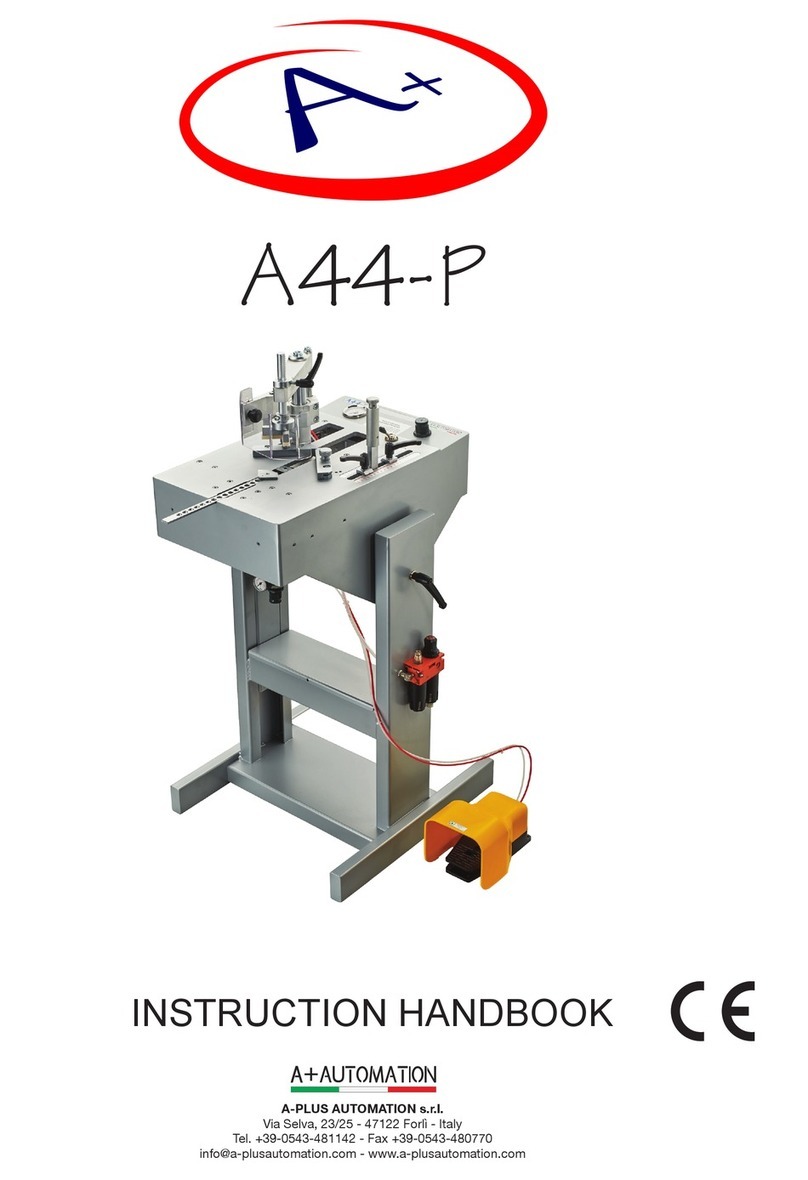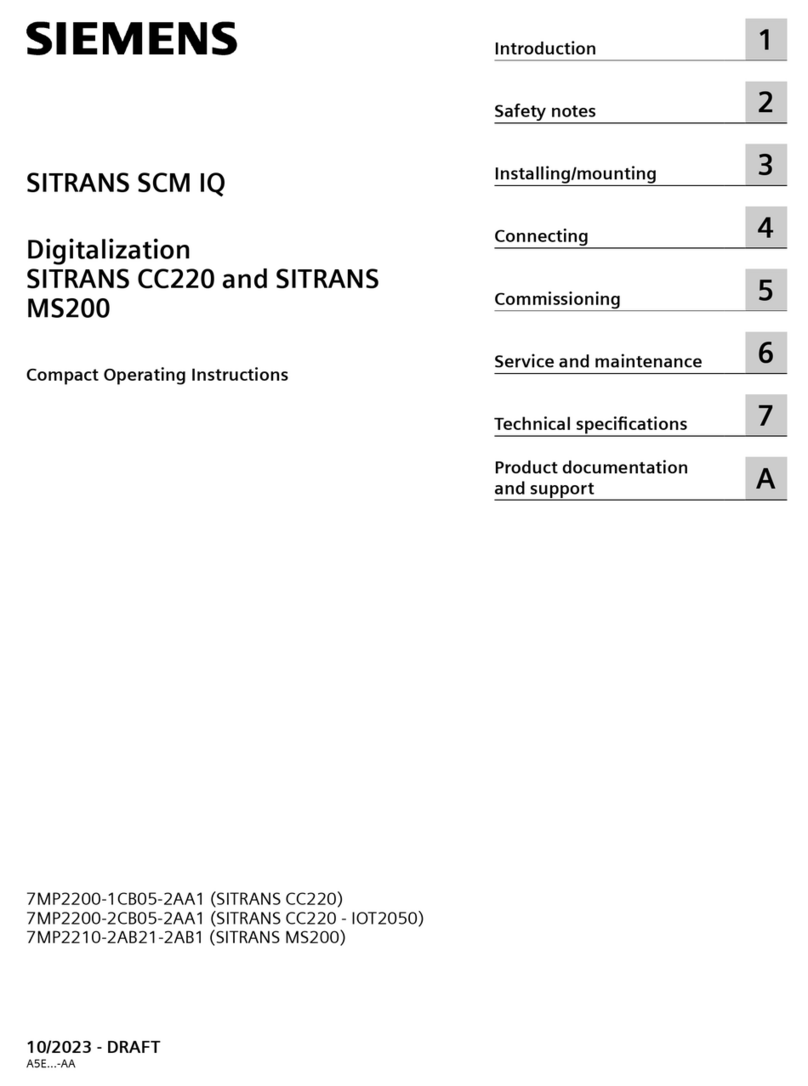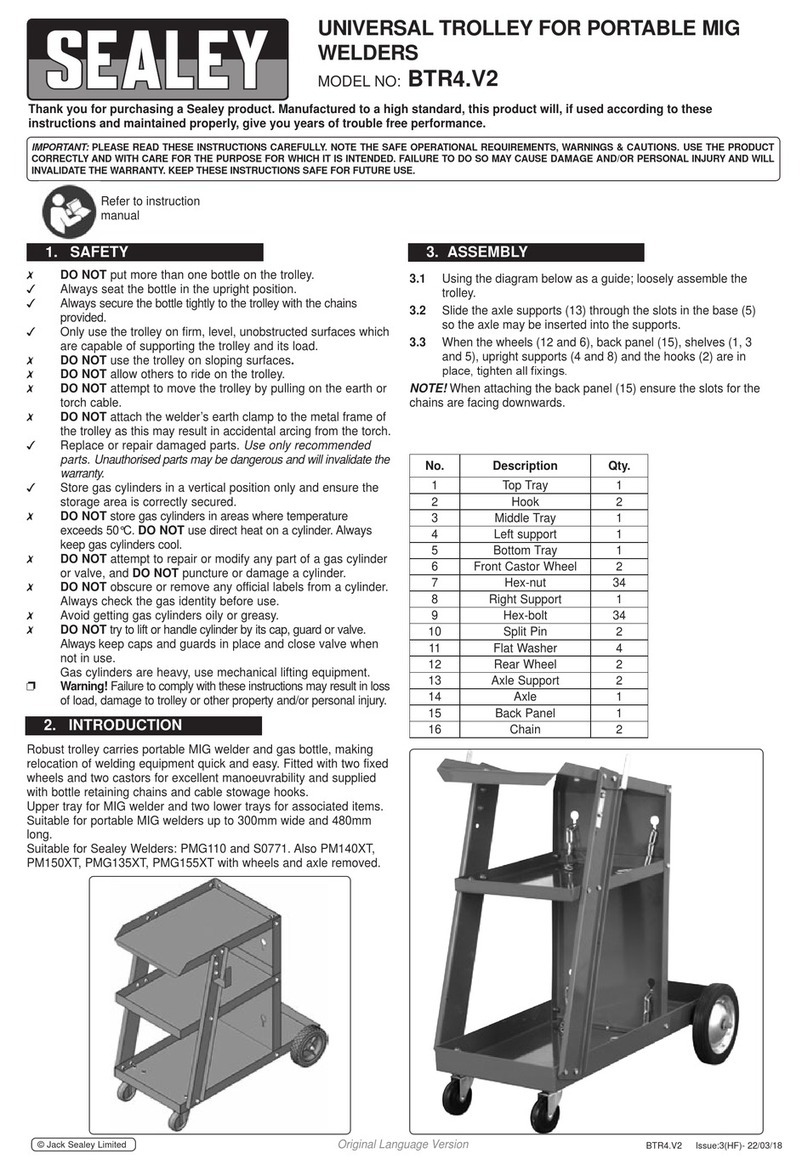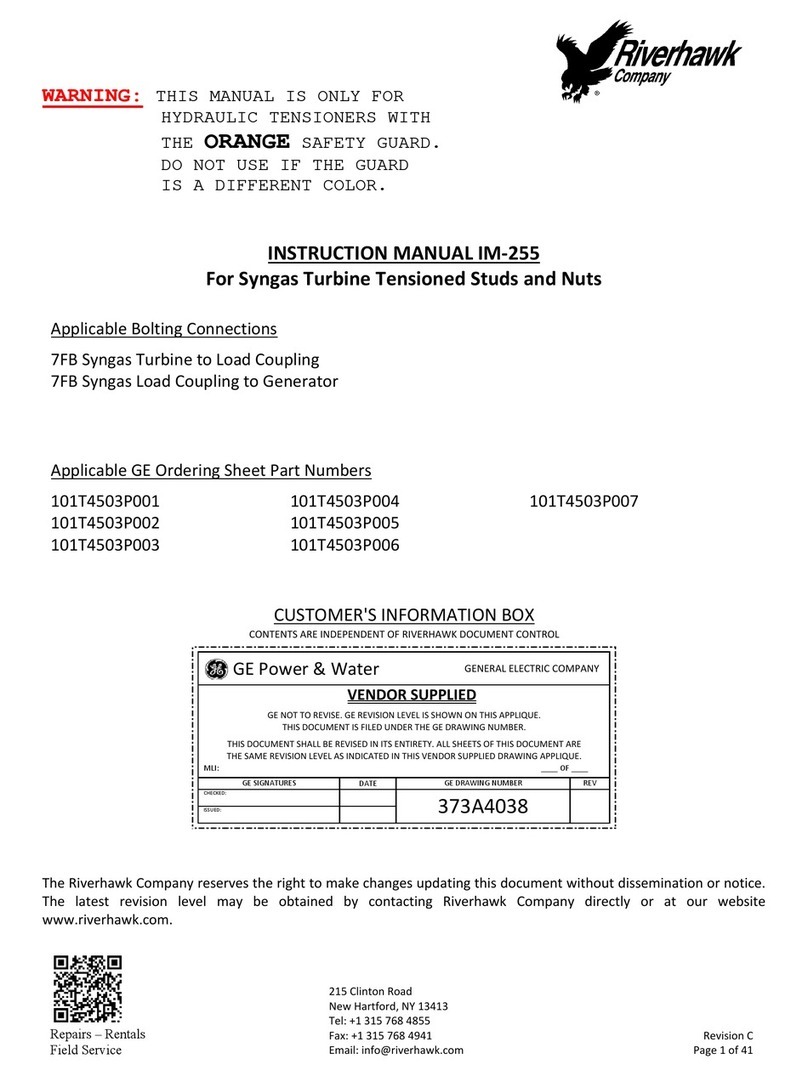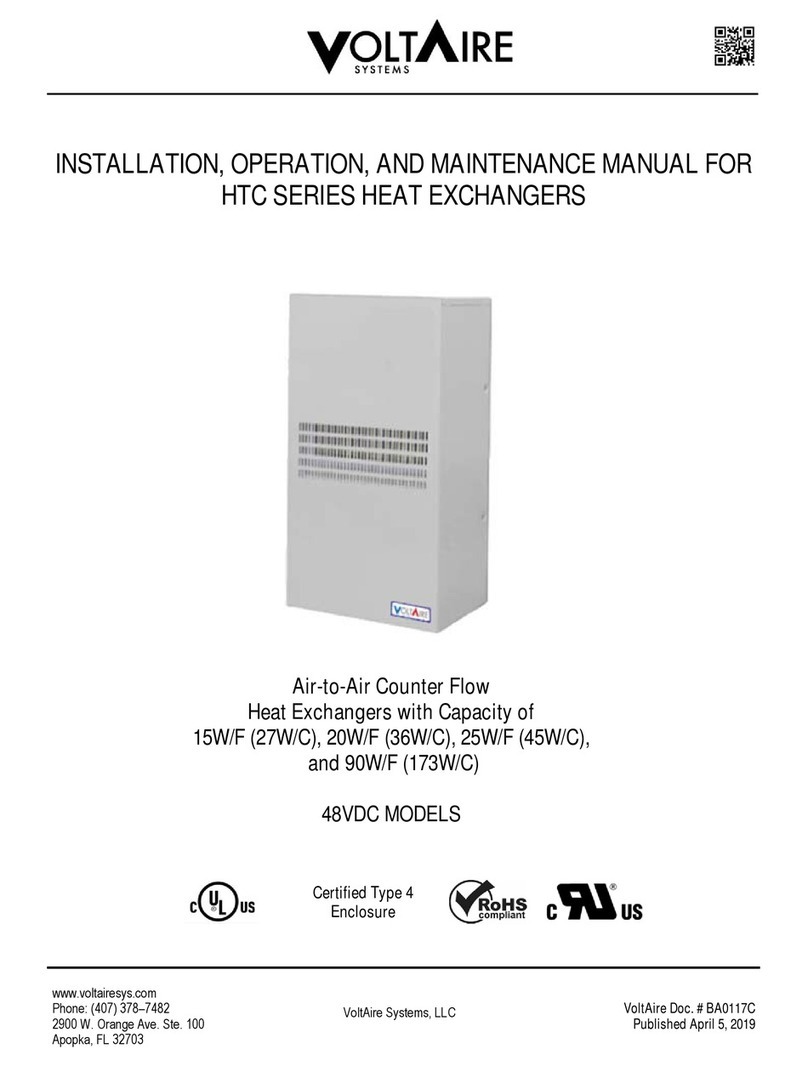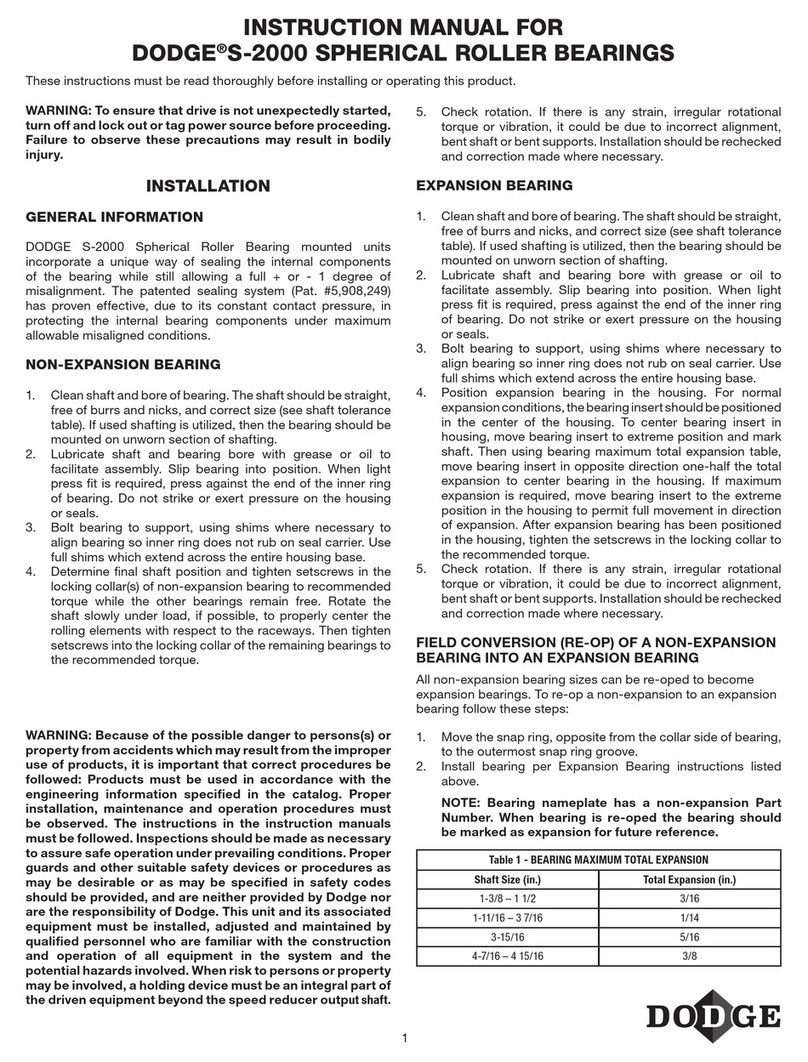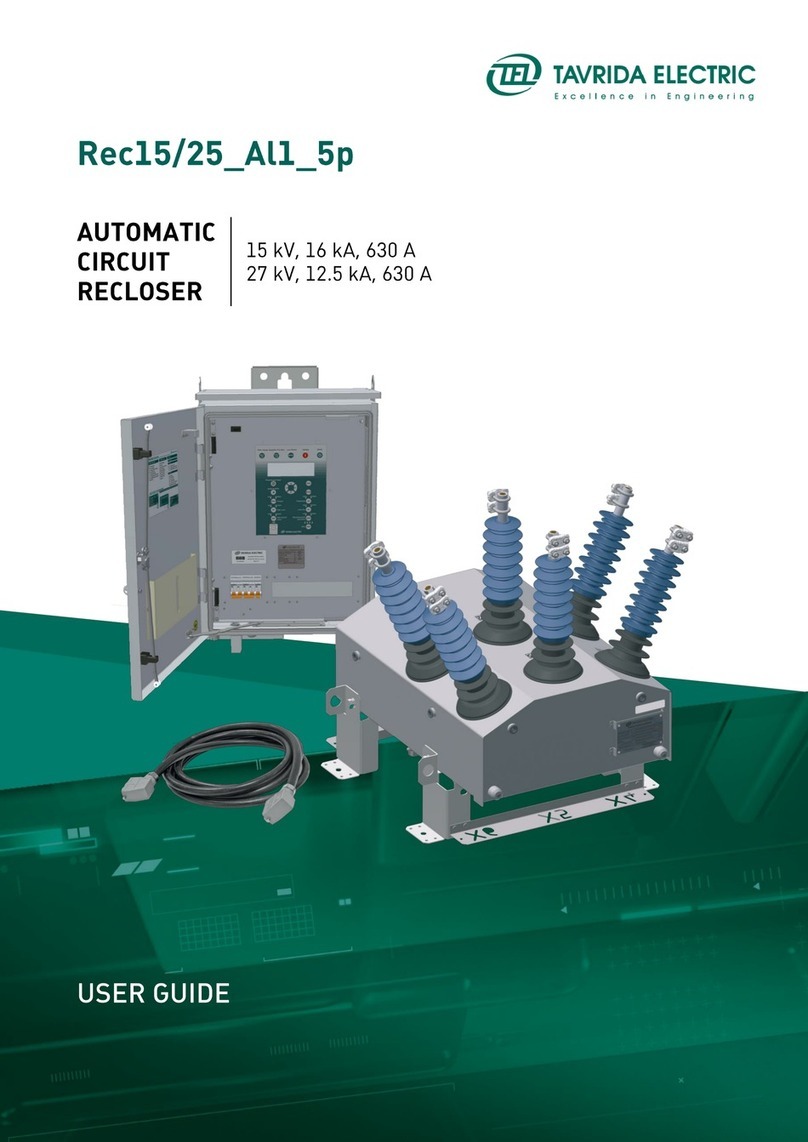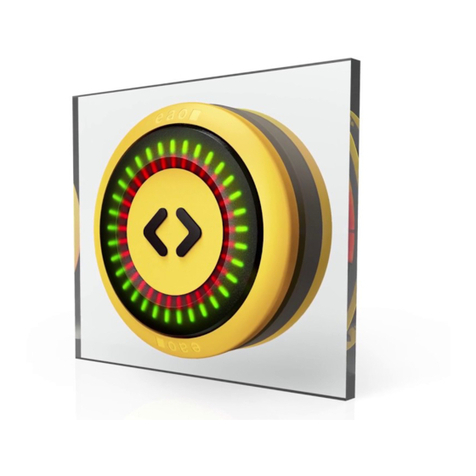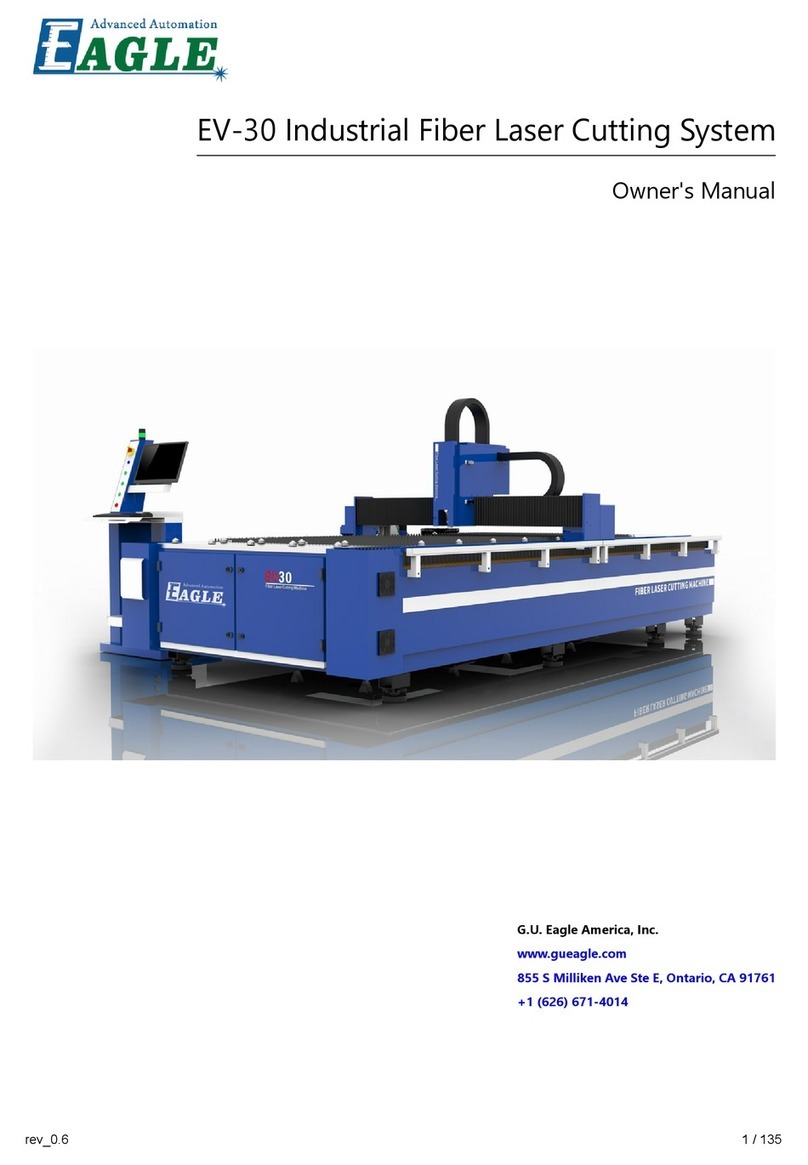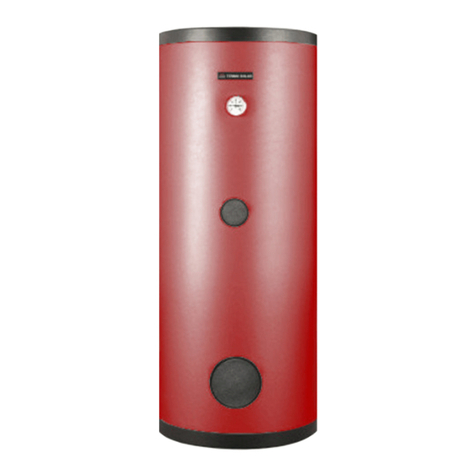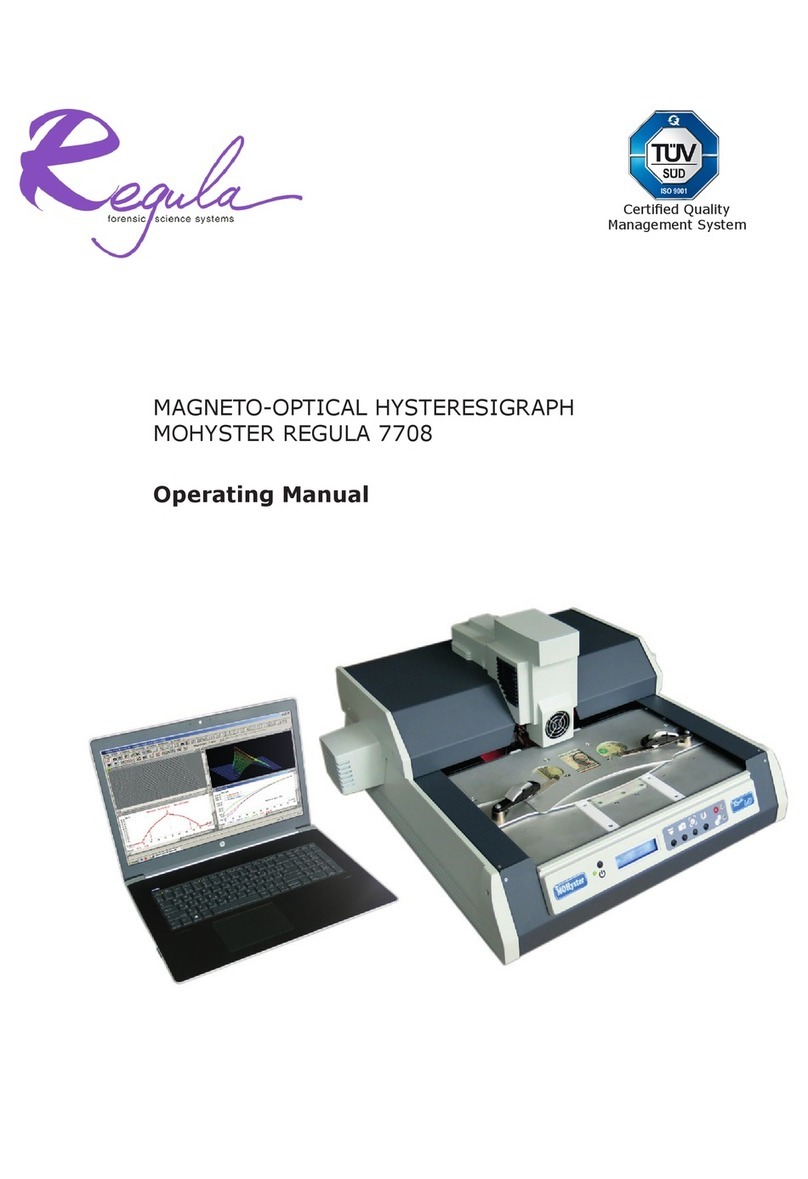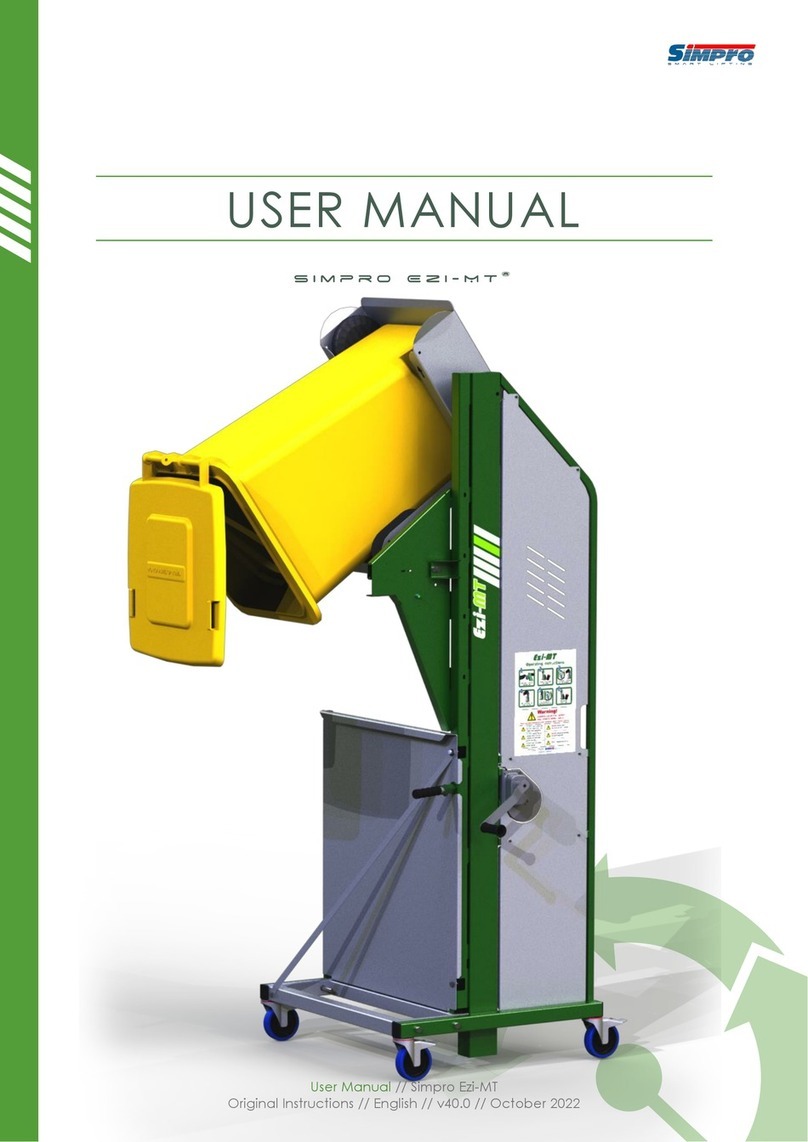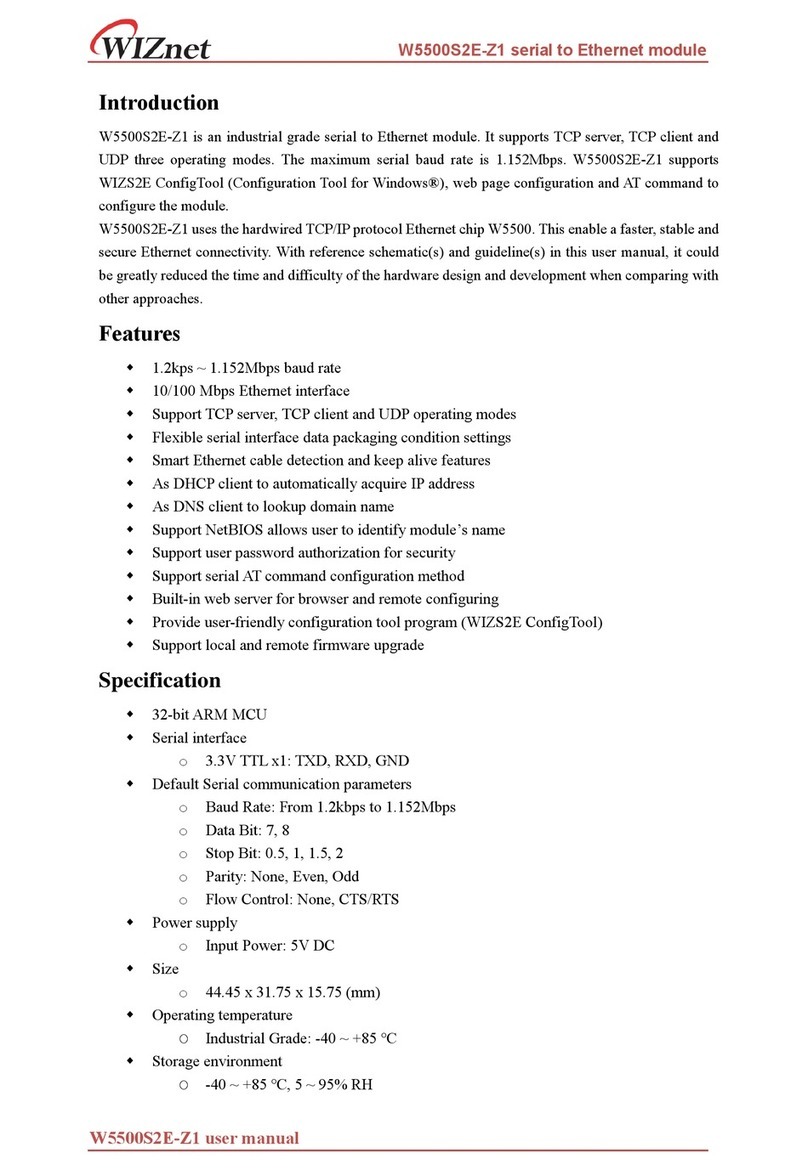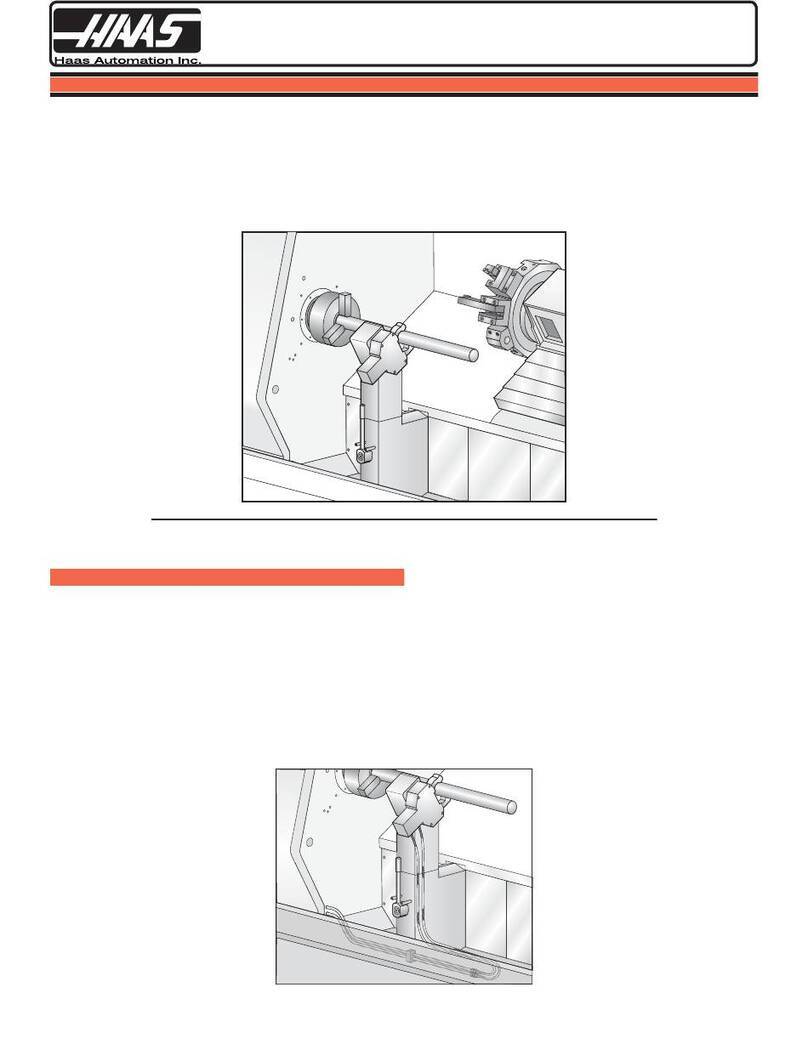A-PLUS AUTOMATION A3-P manual

INSTRUCTION HANDBOOK
A-PLUS AUTOMATION s.r.l.
Via Selva, 23/25 - 47122 Forlì - Italy
Tel. +39-0543-481142 - Fax +39-0543-480770
A3-P

2
A3-P
INDEX
1. GENERAL INFORMATION.......................................................................................................... 4
2. MACHINE DESCRIPTION ........................................................................................................... 6
3. SAFETY..................................................................................................................................... 8
4. HANDLING AND INSTALLATION ................................................................................................ 9
5. OPERATING MODES ................................................................................................................. 16
6. MAINTENANCE ........................................................................................................................ 17
7. DIAGNOSTIC ............................................................................................................................ 18
8. SPARE PARTS............................................................................................................................ 19
9. MACHINE DEMOLITION............................................................................................................ 19
10. ATTACHMENTS......................................................................................................................... 19

3
A3-P

4
A3-P
1. GENERAL INFORMATION
1.1 MANUFACTURER AND MACHINE IDENTIFICATION PLATE
The identication plate illustrated is axed directly on to the machine. The plate contains all identication details and
indications necessary for safe operation.
1.2 TECHNICAL SERVICE REQUEST PROCEDURES
For any requirement, please contact the Manufacturer’s Customer Service.
For any request for technical service, list the data on the identication plate, the approximate number of hours the
machinery has been used and the type of malfunction.
1.3 CERTIFICATION
The machine is produced in conformity to the pertinent European Community Norms in force at the moment of
its introduction on the market.
1.4 WARRANTY
The replacement of defective parts is warranted (counting from the date written on the delivery bill) for a period of:
• Mechanical components 24 months
• Pneumatic part 12 months
The driver blade is tested for more than 1.000.000 working cycles.
The Warranty does not include sending of technical sta. The repair will be performed at A-Plus Automation’s facility
and the freight of shipment will be entirely charged to the Customer. The warranty does not cover the damages
caused by an inappropriate use of the machine or not corresponding to the instructions described in this handbook.
The warranty decays in case of unauthorized modications or because of accidental damages or tampering
performed by unqualied personnel. The warranty also decays if you use wedges dierent from the original special
steel A+ ones. To take advantage of warranty services it is necessary, at the moment you receive your machine to
completely ll out the warranty card and send back as soon as possible to A-Plus Automation. The warranty will
be valid after it is received & recorded at A-Plus Automation.
1.5 PRE-ARRANGEMENTS CHARGED TO THE CUSTOMER RESPONSIBILITY
It is the customer’s duty, on times agreed with the manufacturer, to execute what is indicated in our documentation.
Things normally charged to the customer:
• Premises predisposition, included building works
• Pneumatic supply of compressed air (see at the paragraph 4.5)
1.6 PURPOSE OF THE MANUAL
The manual herein, part and parcel with the machinery, has been designed and built by the manufacturer with the
purpose to supply the necessary information to the persons authorized to operate the machinery during its useful life.
As well as adopting an appropriate utilization technique, the recipients of the information must read and strictly
apply them. This information is supplied by the manufacturer in its own language (Italian) and may be translated
into other languages to satisfy statutory and/or sales needs. A time dedicated to the study of this information, will
permit the user to avoid health and safety risks to personnel and economic loss. The translation in the language of
the country of use, supplied by the manufacturer, its representative or whoever brings the machine to such linguistic
area, must be carried out from the “ORIGINAL INSTRUCTIONS” and must display the phrase “TRANSLATION OF
THE ORIGINAL INSTRUCTIONS”. In the event that the manual herein contains additional information concerning
the ttings of the machinery, said information does not interfere with the reading of the manual.
Keep this manual for the entire duration of its useful life in a well known and easy to access place, available for
reference any time the need should arise.
The manufacturer reserves the right to make modications with no obligation to supply a prior notication.

5
A3-P
1.6 SYMBOLS
SYMBOL MEANINGS
DANGER Indicates situations involving great hazard risks which, if overlooked, could
put people’s health and safety in great danger.
WARNING Indicates technical information of particular importance which must not be
overlooked.
INQUIRY The user is requested to check the proper positioning of any element of the
machine, before operating a certain command.

6
A3-P
2. MACHINE DESCRIPTION
2.1 GENERAL MACHINE DESCRIPTION
The benchtop Frame Assembling Machine A3-P has been realized for frme production.
2.2 CONSTRUCTIVE CONFIGURATION
The main components constituting the machine are:
• Pneumatic clamping device to allow a proper locking of the mouldings to insert several Wedges in dierent
positions
• Magnetic pressure pads of several types, at quick replacement, to have the proper clamping of any prole
• Dual function foot pedal for the separate control of the clamping and wedge insertion
• Pneumatic opening of the Wedge magazine for a very quick reloading
• Wedge heads sizes 7, 10 and 15 mm.
2.3 AXIS
- X AXIS
Movement horizontal.
- Y AXIS
Movement vertical
ìPicture 2. 3 A - Movement directions
2.4 AMBIENT CONDITIONS IN THE INSTALLATION AREA
The installation area must have adequate environmental conditions.
The installation area must meet the following requisites.
• Adequate lighting to European standards (recommended 250÷650 lux)
• Well ventilated rooms
• Adequate relative humidity and temperature. The permitted temperatures go from 5° to 40° C, with a humidity
level not higher than 50% at 40° C or 90% at 20° C.
• The oor, as well as having an adequate load capacity for the machine weight, must be stable and levelled in
order to guarantee a correct support.
X
Y

7
A3-P
2.5 VIBRATIONS
In standard conditions conformed to the indication of machine proper utilization the vibrations do not create
dangerous conditions.The average quadratic weighed level, according to the acceleration frequency to which
arms are exposed does not exceed 2,5 m/s2.
2.6 NOISE EMISSIONS
In standard working conditions the Machine noise power level is:
• Acoustic Continuous Equivalent weighed pression A <70dB
• Acoustic Istantaneous weighed pression <130dB
In case of any machine modication, the above mentioned levels could be changed
2.7 TECHNICAL DATA
We have listed below the Machine’s data and technical characteristics to which you can make reference for any
eventual contact with your distributor for Technical Assistance.
TABLE 2. 7 A Tecnical data
Frames thickness (min-max) 8-100 mm / 1/4" - 4 1/4
Frames width (min-max) 6-150 mm / 1/4" - 6"
Wedges magazine capacity n. 200
Wedges size 7, 10, 15 mm.
Wedges size on request 3, 5, 12 mm.
Pneumatic feed BAR 3-6 / PSI 40-80
Air consumption 3,5 Nl at 5 BAR
0.12 cf3at 73 PSI
Weight approx. 32 kg / 77 lbs
Height of working bench 130 mm / 5”
Overall dimensions 320x480x380mm
13" x 19" x 15"
2.8 EQUIPMENT SUPPLIED
2.8.1 Standard accessories 2.8.2 Optional accessories
• N.1 wedge claw-head mm. 7 • Floor stand
• N.1 wedge claw-head mm.10 • Metal support extensions
• N.1 wedge claw-head mm.15 • Adjustable tilting fences
• N.1 L shaped pressure pad • Special fences for octagons
• N.1 Round pressure pad • Special fences for hexagons
• N.1 Allen Wrench 5 mm. claw-head replacement • Round and square pressure pads in rubber
• N.1 Brass rod magnet to remove Wedges • Wedges claw-heads size 3-5-12 mm
• Double mechanical pressure pad
• Triple mechanical pressure pad

8
A3-P
3. SAFETY
3.1 GENERAL WARNINGS
• The manufacturer, during the design and manufacturing stages, has paid special attention to the aspects that
might jeopardize the safety and health of the personnel that operates the machinery. As well as the compliance
with current regulation on the matter, the manufacturer has adopted all the “rules of good craftsmanship”.
The purpose of this information is to make the user aware to pay special attention in order to foresee any risk.
There is no substitute for carefulness. Safety also lies in the hands of all operators that work on the machinery.
• Carefully read the instructions of the manual supplied with the machinery and the ones directly tted on the
machinery, especially the ones concerning safety. A little time dedicated to the study of this manual will prevent
unpleasant accidents.
• Pay attention to the meaning of the symbols of the plates tted on the machinery; their shape and colour are
important for safety purposes. Keep them readable and comply with their information.
• Do not tamper with, do not dodge, eliminate or bypass the safety devices installed on the machinery. The non
compliance with this requirement may cause serious risks for personnel’s safety and health.
• The personnel that carries out any type of operation during the entire useful life of the machinery must have
specic technical competence, special skills and experience acquired and acknowledged in the specic sector.
The lack of these requisites may jeopardize the safety and health of personnel.
• During operation only use the personal protection clothes and/or devices listed in the instructions supplied
by the manufacturer and the ones provided for by current regulations on safety at work.
• During the normal use or for any intervention, keep the surrounding area in adequate condition, especially the
one accessing the controls, in order to avoid jeopardizing the safety and health of personnel.
• The operator, as well as being adequately informed on the use of machinery, must possess skills and competence
adequate to the type of working activity to perform.
• The machine must only be used for the applications intended by the manufacturer. Only use the machinery for
the purposes intended by the manufacturer. The employment of the machinery for improper uses may cause
risks to the safety and the health of personnel and economic loss.
• Provide appropriate containers to stock the pieces you will be working with.
• Keep your foot o of the pedal and disconnect the main air supply while performing any machine maintenance .
3.2 SCHEDULED USE
The Machine is designed and built to execute junctions of frames.
The machine is projected for manual use only (under operator control).
3.3 INADVISABLE USE
The machine can not to be used:
• For uses dierent from those listed in 3.2 paragraph • Outside in all weather severity
• In an explosive or aggressive atmosphere where there is a
high density of dust or oily substances suspended in the air
• For molding to be assembled not suitable with
the machine’s characteristics.
• In a ammable atmosphere
3.4 DANGEROUS AREAS
Working area -Area of frames assembly, wedges driving/insertion.
Dangerous areas - include the movable parts and surrounding zones.
Figure 3.4.A - Working area and dangerous zones
Dangerous Area

9
A3-P
3.5 PROTECTION DEVICES
The machine is equipped with protection shield for persons exposed to the risks due to the transmission of mobile
elements taking part in working (driver blade, horizontal clamp, vertical clamp).
3.6 STOP MODE
Uncontrolled stop It is obtained by disconnecting the quick connect tting from the main air supply.
Controlled stop It is obtained by lifting the foot from the pneumatic pedal not allowing the wedge to drive
3.7 SAFE WORKING PROCEDURES
The machine is projected and realized to eliminate any risk connected with its use.
The user is requested to achieve an adequate training to be instructed by their distributor.
The other risks related with using the machine are:
• Finger crushing in the frontal and vertical clamp working area
It is necessary to carefully follow the following instructions:
1. Keep the ngers away from frontal and vertical clamp working areas
2. Disconnect the air pressure and during any maintenance interventions
3. Keep the foot away from the pedal during machine maintenance
3.8 DESCRIPTION OF SAFETY SIGNS
Some of these signals are applied on the machine. Their meaning is specied on their side.
Make sure that the plates are perfectly readable, otherwise replace them with new ones to be tted correctly in place
Adhesive sign concerning the nger danger zone
4. HANDLING AND INSTALLATION
4.1 HANDLING
The personnel in charge of loading, unloading and moving the machinery must possess the skills and experience
acquired and acknowledged in the specic sector, and must thoroughly know the lifting means to be employed.
The machine has to be shipped in a safe way to avoid any damage to its parts
• All the protections and guard devices must be properly closed and locked.
• The machine has to be shipped like it is positioned for installation.
• Before the shipment it is necessary to lubricate the parts which are not painted.
• According to the type of shipment, it is necessary to protect the machine from any jarring impact or stress
Figure 4.1A – machine handling indications
Machine total weight: about 35 Kilos / 77 lbs

10
A3-P
Lifting must be done by using a specic device.
4.2 WAREHOUSING AND STORAGE PROCEDURES
• In order to avoid that the components cause dangers or are damaged, the storage area must be covered
(preferably a closed area) and accessible only for authorised personnel.
• Avoid corrosive materials that could touch the machine
• Lubricate the parts which are not painted or chromed.
4.3 UNPACKING
According to the installation requirements, the personnel authorised by the manufacturer will unpack the components
in the most suitable way and will check their integrity. Keep all packages (carton box, pallets, etc.) for future use
and dispose of the protection materials (nylon, polystyrene, etc.) according to the laws in force.
4.4 PRELIMINARY ARRANGEMENTS
In order to install the machine it is necessary to prepare a working area (a table) adequate to the machines dimensions
and the length of moulding you will be working with. To fulll the characteristics of precision and steadiness, the
bench frame assembling machines must be positioned on a solid and leveled plane able to sustain the weight of
the machine. The bench must be studied and prepared by the customer and/or qualied sta.
4.5 PNEUMATIC CONNECTION
The machine is controlled by a dual function foot pedal.
The 3 pipes for the pedal must be inserted into the 3 ttings located on machine’s right side in the following sequence
Upper connection Red pipe into the red tting (external side)
Central connection Blue pipe into the blue tting (central tting)
Lower connection White pipe into the neutral tting (lower tting)
Use the supplied quick disconnect
fitting to connect to the air
compressor system. You could
use also another tting suitable
with your pneumatic system.
Once you have connected the machine to the the pneumatic system, check the operation of the foot pedal in
the following way:
• Move the vertical rod fully upwards by pressing the lever located on the side of the clamp & pull the rod
upwards. See picture 16 in section 4.8.2b
• Pressing the foot pedal half way down activates the locking of the fence, the horizontal clamp and the vertical
clamp.
• The foot pedal pressed full down activates the wedge driving.

11
A3-P
It is advisable to install a lter on the air compressed system to obtain clean and lubricated
air. Use only silicone lubricating oil for pneumatic systems. The use of inadequate oil could
damage the valves.
Check the foot pedal operation when the wedge magazine is closed. The foot pedal
control is deactivated when the wedge magazine is opened.
4.6 PRELIMINARY CONTROLS
Before setting up the machine, execute checks to prevent mistakes or accidents during setup.
• Verify that machine has not been damaged.
• Verify the pipes integrity
4.7 MACHINE ARRANGEMENT
4.7.1 Wedges magazine loading
To load the wedge magazine proceed as follows:
• Move the claw pusher backwards by ipping the special lever
located on the right side of the machine working bench. This will
give you access to the wedge magazine (see g. 7).
Picture 7
• Insert one wedge strip into the magazine. Make sure that the
sharpened edge of the wedges (glue side) faces up and that they
are loaded with the "V" of the wedges pointing in the direction
indicated in the gures 8 and 9. Check to see if the wedge size is
suitable with the type of claw-head mounted.
Picture 8
• Move the claw pusher forward by ipping the control lever (see g.7)
Picture 9

12
A3-P
4.7.2 Wedge guide head replacement to change Wedges size
The wedge guide head must be changed each time you use wedges of dierent sizes. Proceed as follows to
replace it:
• Loosen the locking screw of the wedge guide head using the proper
5 mm Allen wrench (the screw is on the opposite side from the
wedges magazine(See g. 10)
• Take out the wedge guide head
• Move the clawpusher backwards by ipping the special lever
located on the right side of the machine working bench (see g. 7).
• Remove all the wedges that are still in the magazine (using the
proper brass magnet, if necessary).
• Insert the new wedge strip (of desired height) into the magazine
• Move the clawpusher forward by ipping the control lever (see
gure 7).
• Insert the new size wedge guide head to match the wedges you
will be using (see g. 11).
• Tighten the locking screw of the wedge guide head (see g.10).
Picture 10
Picture 11
4.8 ADJUSTMENTS
4.8.1 Wedge inserting positions adjustment
To properly position the mouldings to be assembled, the A3-P is equipped with a 90° fence. The fence can be
shifted forward or backward in order to allow the proper positioning of the wedges in the moulding the fence
stops (backward and forward) can be set with precision by means of locking clamps (see g. 13). The operator
can easily use the machine to insert wedges with extreme precision into 2 dierent positions (g. 14). You can also
stop anywhere in between these two fence stops to add more wedge insertion positions.
Picture 13 Picture 14
4.8.2 Vertical clamp adjustment
The vertical clamp can be adjusted in height and position. Proceed as follows to adjust them:

13
A3-P
4.8.2a Vertical clamp position adjustment
• Position the mouldings to be assembled on the working bench
• Select the pressure pad suitable with the prole of the moulding
to be assembled and put it on bottom part of the the vertical bar
• Loosen the handle (see g.15) that locks the clamp,which
holds the vertical bar. This will permit its movement forward or
backward. You want the pressure pad directly over the lath in the
same position over the Wedge insertion point.
• Tighten the handle once you have reached the proper position
Picture 15
4.8.2b Vertical clamp height adjustment
• Press the lever (see g. 16) and adjust the pressure pad height
over the frame. It suggested that you put the bar height between
5 & 8 mm over the moulding. This will help avoid any accidental
ngers crushing.
• Release the lever once once you have reached the proper height.
• Lower the vertical clamp by pressing half way down on the foot
pedal. This will verify that the mouldings to be assembled are
properly clamped
• Press all the way down on the foot pedal to drive the wedge into
the laths. Picture 16
4.8.3 Horizontal clamp adjustment
The horizontal clamp has a series of holes in the at bar (see g.17).
Lift the bar, to take it out of its initial position. You will now be able to move it forward and backward. To lock the
bar it is sucient to insert it into the proper peg located in the middle of the guide channel.
Proceed as follows to position the frontal Clamp correctly:
1. Remove the bar o of the peg by lifting it by about 10-15 mm (Picture 17). Move it forward until it touches the
moulding to be assembled (see Picture 18);
2. Lower the bar into the next available hole and over the peg.
Picture 17 Picture 18
In case of continued use without needing to remove the frontal clamp from its position, it is
possible to x it into the peg using the proper screw.
4.8.4 Working pressure adjustment
The working pressure must be adjusted to the hardness of the mouldings to be assembled. The pressure regulation
allows you to change the clamping pressure of mouldings to be assembled. Too high of a working pressure can
cause a poor junction and (especially on small-size frames) the moulding could be crushed. Too low of a working

14
A3-P
pressure can cause an incomplete insertion of the wedge into the frame. The working pressure is adjusted by
means of the regulator on the panel (see g. 19). Proceed as follows to adjust the working pressure:
1. Pull up the regulator cap by about 3÷4 mm. This will unlock it.
2. Turn it clockwise to increase the pressure and counter-clockwise
to decrease it.
3. Push the regulator cap back down to lock it into position
Picture 19
DO NOT ADJUST the pressure if the machine is not connected to the air supply.
The suggested pressures are:
Soft woods (samba,. poplar, ...) 1.5 - 2.0 Bar
Medium (ramin, pine, ...) 2.0 - 3.0 Bar
Very hard woods (oak, MDF), ... 3.0 - 5.0 Bar
The above listed values apply to 7 and 10 mm high Wedges.
Increase the pressure by 10 % for 15 mm high Wedges.
When stacking 2 or more Wedges in the same position, increase the working pressure by 20%.
4.8.5 Protective shield adjustment
Machine is equipped with a protective shield made of transparent plastic material. (see g. 20).
In order to adjust the protection shield, proceed as follows:
• Loosen the 2 knobs which hold the shield in place and lift or lower
it to a height of about 6-8 mm from the top of the moulding.
• Tighten the knobs to lock the protection shield.
picture 20
Even if the protective shield is properly adjusted, it is necessary following instructions listed below:
• Keep the ngers away from the frontal and vertical clamp working area.
• Disconnect the air supply during any maintenance intervention.
• Keep your foot o of the pedal while adjusting the machine.
For some operations, it is necessary to open the protection shield by turning it.
Opening the protection shield or the wedge magazine, the foot pedal to be deactivated and
consequently machine cannot opearate.

15
A3-P
4.9 ITEMS TO BE PERFORMED BEFORE OPERATING THE MACHINE
Once the machine has been properly installed (as previously described), check that:
• The magazine is loaded with the type of Wedges suitable with the mouldings to be assembled
• The adjustment of the vertical and horizontal clamps are correct (chapter 4.8.2 and 4.8.3)
• The protective shield is properly positioned (see chapter 4.8.5)
• The working pressure is adequate to the wood hardness (see chapter 4.8.4)
• The mouldings to be assembled are properly positioned on the work bench
• Pressing halfway down on the pedal both the frontal and vertical clamps hold the frame properly
•
Press the pedal all the way down to insert the wedge
If you want to insert 2 or more wedges one upon the other in the same position, you must
release the pedal until halfway and then press it full down again to insert the second wedge

16
A3-P
5. OPERATING MODES
5.1 OPERATORS
The machine has been designed to be used by only one operator.
The operator, as well as being adequately informed on the use of machinery, must possess skills and competence
adequate to the type of work to be performed.
Even after being adequately informed, during the rst use, if necessary, simulate some operating maneuvers to
identify the controls, especially the ones for starting and stopping the machinery and their main functions.
How to operate in case of emergency , where to nd the individual protection means and how to use them properly.
5.2 DESCRIPTION OF FUNCTIONS
The machine has only one possible operating mode: Manual operation by using the pneumatic foot pedal.
Press the foot pedal half way down to clamp the frames
Press the foot pedal all the way down to drive a wedge.
To assemble a frame junction, you must operate as follows:
1. Set the inserting positions by means of the fence locking clamps
2. Place the moulding on the work bench. Move the fence to the rst inserting point.
3. Adjust the vertical clamp height and position
4. Adjust the frontal clamp position
5. Verify and adjust the proper working pressure, using the pressure regulator, according to the type of moulding
to be assembled are the mouldings to be assembled.
6. Press half way down on the pneumatic pedal to verify the proper position and clamping of the moulding.
7. Press the pedal all the way down to insert the Wedge. If you want to insert 2 or more Wedges, one upon the
other in the same position, you must release the pedal halfway and then press it all the way down again to
insert the second Wedge and so on.
8. Completely release the foot pedal
9. (If the assembly requires it) Move the moulding and the fence to the next inserting point and repeat the steps
6,7 and 8.
5.3 TIPS FOR QUALITY JUNCTIONS
a) Wedge types
In order to allow the machine to make excellent quality joints using dierent materials, it has been necessary to
manufacture dierent Wedges types for dierent uses (see attachment D).
Wedges can be classied in three dierent groups:
Material Suggested code Color Ref.
soft materials (wood, soft plastic) SW Green
for medium materials (wood, ...) MW Gray
for hard materials (wood, MDF, HDF) HW Red
b) Assembling positions
It is advisable to operate as follows in order to achieve the best results in terms of junction quality:
• Never drive Wedges near the external vertex. The minimum
recommended distance from the external vertex is at least 10 mm.
• When you want to make the junction using only one Wedge, the
most suitable position is in the middle of the moulding (see g. 21)
• In case you want to insert 2 or more Wedges into each junction,
we recommend you to insert the most external one 1/3 from the
external vertex and the most internal one 1/4 from the internal
vertex (not less than 5mm).
picture 21

17
A3-P
5.4 MACHINE STOP
To stop it, lift your foot from the pedal.
It is possible also to disconnect the quick connect tting from the air supply.
In case on long inactivity periods it is necessary to disconnect the quick connect tting from pneumatic system.
6. MAINTENANCE
6.1 RECOMMENDATIONS FOR MAINTENANCE
Carry out maintenance or repair operations with the machine isolated from air supply, as indicated by the
Manufacturer.
Before performing any cleaning intervention, the operator must disconnect the air supply
During the maintenance or repair operations is suggested to proceed as follows:
• Before starting any operation place a sign “machine under maintenance” in a well visible position.
• Do not use solvents or ammable materials
• Do not step on the machine parts, because they have not been projected to sustain the weight of persons.
• Put on a pair of safety glasses.
• Once all the operations are nished replace any protections and shields you removed or opened.
6.2 CLEANING THE MACHINE
The machine is of simple construction and the mechanical parts do not require any special maintenance.
Keep the machine in maximum eciency conditions and perform all the scheduled maintenance operations
provided by the manufacturer. Good maintenance will result in better performance, a longer operating life and
keep the safety requirements unchanged over time.
Follow the rules listed below:
• Regularly remove glue or other residues from the wedges claw-head and from the upper part of the driver blade;
• Always keep the wedge magazine clean and without residues.
• Remove any residues from the wedges guide “L” shaped support.
• Do not use water to clean the machine, otherwise metallic parts may rust.
6.3 ROUTINE MAINTENANCE OPERATION
Frequency Ispection Action
Every 1.000.000 wedges shot wedges driver blade Replace
Every 300 working hours Movable parts lubrication Lubricate
Every 5.000.000 wedges shot Wedges claw-heads Replace
Every 5.000.000 wedges shot “L” shaped supports (wedges guide) Replace
20 million of wedges shot Valves and Reducers Check and in case, replace
Every 6.000.000 wedges shot Frontal and vertical clamping gaskets Replacement in case of leak of air
6.4 RECOMMENDED OIL
Use CASTROL MAGNA GC 32 or equivalent oil
Unsuitable lubricants may cause valve seal problems (seals may become too large) and
consequent Valve jamming.

18
A3-P
7. DIAGNOSTIC
7.1 SAFETY WARNINGS
The interventions must be executed by personnel properly trained for this specic machine and they must take
all precautions in order to avoid accidental starts.
During the tests, it is suggested to remove the vertical clamp assembly or position it to its full upwards position.
TABLE 7. 2 - A
TROUBLE POSSIBLE CAUSE REMEDY
Pressing the foot pedal the Wedges
ejection is discontinuous (sometimes
it goes o)
Insucient working pressure • Check that the minimum value indicated
from main gauge is higher than 2,5 Bar
Wedges wrongly positioned into
the magazine
• Check that the Wedges sharpened side
(glue side) faces up
• Check that Wedges V vertex is pointing
toward machine’s external side
Guide channels damaged or
jammed
• Check that the guide channels are not dirty
or jammed
Claw pusher has insufficient
thrust
• Check that the pressure of the regulator
feeding the claw pusher cylinder is at least
1,0 Bar. If necessary, increase it by 10%.
Claw head not suitable with
Wedges size
• Check that the number engraved on the
wedge claw head match the Wedges size
Faulty Wedges • Replace the Wedges (from a different
packaging)
Insucient working pressure • Check that the air pressure line.
Opened Wedges magazine • Close the magazine by means of the
special lever
Faulty valves • Replace the foot pedal valve
• Replace the control valves
Pressing the foot pedal for several
times the machine’s working cycle
that was correct at the beginning
becomes irregular later
Jammed valves because of
surplus of oil or condensation
liquid in the actuation hoses Ø
4mm
• Remove the surplus of oil and condensation
from the valves by disconnecting the
hoses/pipes one by one. This will force out
the oil or condensation liquid.
Pressing the foot pedal the working
pressure indicated on the regulator
deeply decreases (over 1,0 bar)
Faulty pressure regulator • Replace the regulator
Air supply line too long or of
inadequate diameter
• Replace the air line with a new one of
bigger size
Pressing the foot pedal the machine
works properly, but once the pedal is
released you can note a certain delay
in the re-positioning of the driver
blade and/or vertical clamp cylinders
Faulty or jammed valves
• Remove the surplus of oil and/or
condensation
• Replace the foot pedal valve
• Replace the faulty control valves
Wishing to insert several Wedges
one upon the other in the same
position, they do not stack properly
or tilt during their insertion
Unsuitable Wedges • Replace the Wedges with suitable ones
Unsuitable frames clamping (the
frame moves during the Wedge
insertion)
• Check and reposition the vertical clamp
• Increase the pressure by using the
pressure regulator
• Replace the pressure pad with the proper
one
Wore and torn driver blade • Replace the driver blade
Jammed driver blade
• Revive and clean the driver blade’s upper
part by removing any material jamming the
upper prole

19
A3-P
7.3 TECHNICAL SERVICE REQUEST PROCEDURES
For any requirement, please contact the Manufacturer’s Customer Service.
For any request for technical service, list the data on the identication plate, the approximate number of hours the
machinery has been used and the type of malfunction.
E_Mail: [email protected]
FAX: +39-0543-480770
Via Selva, 23/25 - 47122 Forlì - Italy
In the USA please contact:
E_Mail: [email protected]
FAX: 248-851-8777
31874 Northwestern Highway
Farmington Hills, MI 48334
8. SPARE PARTS
8.1 SPARE PARTS LIST
Even though the machine has been submitted to several tests and functional checks, we listed below the
components that we suggest you to have a minimum and sucient set of. This will help guarantee the shortest
possible downtime.
TABLE 8.1 - A
COMPONENT
• WEDGES DRIVER BLADE
• WEDGES CLAW-HEADS
• “L” SHAPED SUPPORT (WEDGES GUIDE)
• VALVES-REDUCERS-REGULATORS
• VERTICAL AND HORIZONTAL CLAMPING
• GASKETS
8.2 SPARE PARTS ORDERING
We remind you that only a qualied technician can repair the machine.
Therefore we suggest the intervention of your local distributor or A-Plus Automation Center of Technical Assistance,
which has access to qualied sta, proper equipment and tools, and who uses original spare parts.
To order the above spare parts, send the following data by fax, e-mail or letter:
• Model of the Machine
• Code of drawing scheme
• Reference number of spare part or group indicated on the mechanical drawing
• Code number of single or group spare part
9. MACHINE DEMOLITION
9.1 MACHINE DEMOLITION
When scrapping the machine, group components by chemical composition and dispose of separately in accordance
with applicable legislation. Do not dispose of non-biodegradable materials, lubricant oils and non-ferrous articles
(rubber, PVC, plastics etc.) in the environment.
10. ATTACHMENTS
10.1 DECLARATIONS
You can nd here attached the following declarations
• Declaration of conformity to the Norm 89/392/CEE
10.2 SCHEMATICS
You can nd here attached the following schemes:
• (A) Mechanical Schematic
• (B) Pneumatic Schematic
• (C) Plate locations
• (D) Sharpening Table

20
A3-P
FAC-SIMILE
DICHIARAZIONE CE DI CONFORMITÀ
2006/42/CE (Allegato II parte A)
Il sottoscritto, rappresentante il seguente fabbricante
Costruttore A-Plus Automation S.r.l.
Indirizzo Via Selva, 23/25, 47122 Forlì (FC) Italia
ha incaricato la seguente persona autorizzata a costituire e conservare il fascicolo tecnico
Nome A-Plus Automation S.r.l.
Indirizzo Via Selva, 23/25, 47122 Forlì (FC) Italia
Il fabbricante dichiara qui di seguito che la macchina
Denominazione generica /
commerciale A3-P
Funzione Assemblatrice pneumatica per cornici e telai
Modello A3
Tipo A3-P
Matricola A3.18.xxxx
Anno di costruzione 2018
risulta in conformità a tutte le diposizioni pertinenti previste dalle seguenti direttive comunitarie
(comprese tutte le modiche applicabili)
2006/42/CE - Direttiva Macchine
L’elenco delle principali norme seguite per la parte applicabile e secondo quanto documentato nel fascicolo
tecnico, è allegato alla presente dichiarazione.
Forlì, 02/01/2018.
L’amministratore, Dennis Zavoli
- LINGUA ORIGINALE -
Via Selva, 23/25 - 47122 Forlì - Italy
Tel. +39 0543 481142 / Fax. +39 0543 480770
info@a-plusautomaon.com/www.a-plusautomaon.com
A-Plus Automaon s.r.l.
C.F. e P.IVA IT 04349600405 – REA: FO-404194
Table of contents
Other A-PLUS AUTOMATION Industrial Equipment manuals
